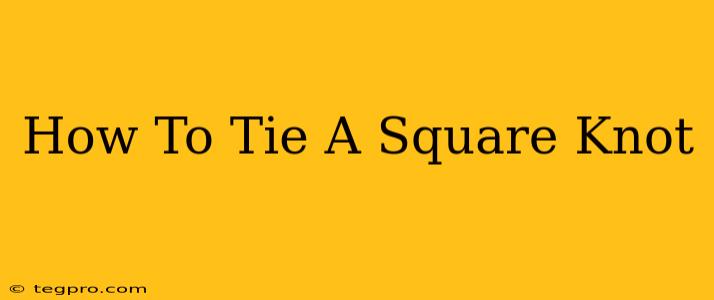Tying a square knot, also known as a reef knot, is a fundamental skill with countless applications. From securing ropes and cords to crafting jewelry and even tying shoelaces (though a different knot is more common), mastering this knot is incredibly useful. This guide will walk you through the process clearly and concisely, ensuring you can tie a secure and reliable square knot every time.
Understanding the Square Knot
Before we dive into the steps, let's understand what makes a square knot different from other knots. A square knot is formed by tying two overhand knots in opposite directions. This creates a knot that's relatively compact, strong, and easily untied—when tied correctly. The key to success lies in understanding the directional component of each overhand knot.
How to Tie a Square Knot: A Step-by-Step Tutorial
Follow these simple steps to master the art of tying a square knot:
Step 1: Preparing the Ropes
Start with two ropes or cords of roughly equal length. Hold one rope in each hand, letting the ends hang down. The lengths should be sufficient for the intended purpose.
Step 2: The First Overhand Knot (Right Over Left)
- Cross the right rope over the left rope.
- Bring the right rope under and through the loop formed by the crossed ropes.
- Pull both ropes gently to tighten the overhand knot. This is crucial; a loose first knot will lead to an insecure final knot.
Step 3: The Second Overhand Knot (Left Over Right)
- Now, cross the left rope over the right rope. Notice the direction is opposite to the first knot.
- Bring the left rope under and through the loop created by the crossed ropes.
- Carefully tighten the second overhand knot. Again, ensure it's snug.
Step 4: Checking Your Work
Gently pull on both ends of the combined ropes. A correctly tied square knot will lie flat and symmetrical. If it's twisted or uneven, you've likely made a mistake – the most common error is tying both overhand knots in the same direction, resulting in a granny knot, which is significantly weaker and prone to untying itself.
Step 5: Troubleshooting a Granny Knot
If your knot looks more like a twisted mess, don't worry! Simply untie it and try again, paying close attention to the directions in steps 2 and 3. Remember: Right Over Left, then Left Over Right.
Common Uses of the Square Knot
The square knot's versatility is a key reason for its popularity. Some common applications include:
- Joining two ropes: This is perhaps the most common use, useful in various situations from camping to sailing.
- Tying packages: For securing items neatly.
- Creating decorative knots: In crafts and jewelry-making.
- Basic first aid: While not for critical situations, it can be used for simple bandages in emergencies (Always seek professional medical attention for serious injuries).
Tips for Tying a Perfect Square Knot Every Time
- Practice: The more you practice, the easier it will become. Start with thicker ropes to make the process more visible.
- Visual Learners: Watch videos! Many helpful videos demonstrate the process visually.
- Patience: Don't get discouraged if it doesn't look perfect at first. Keep practicing, and you'll master it.
Mastering the square knot is a valuable life skill. With a little practice, you'll be tying secure and reliable knots in no time!

